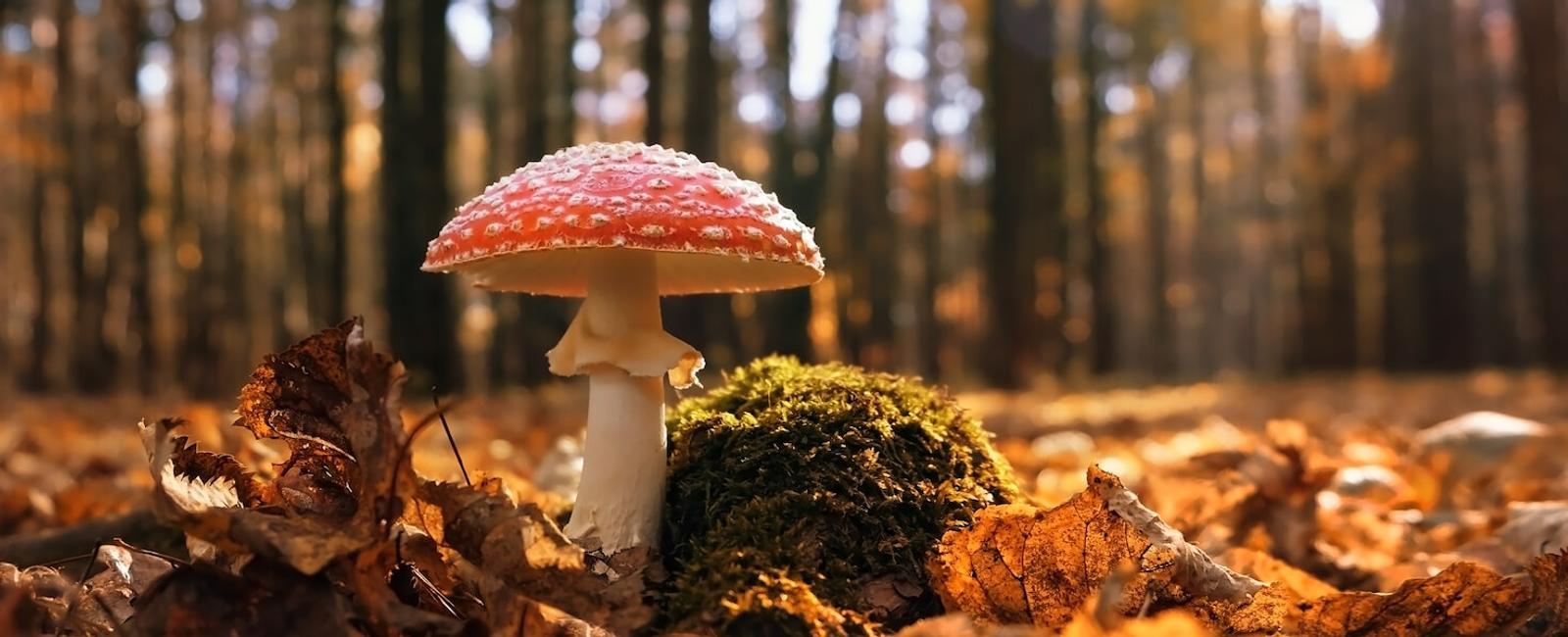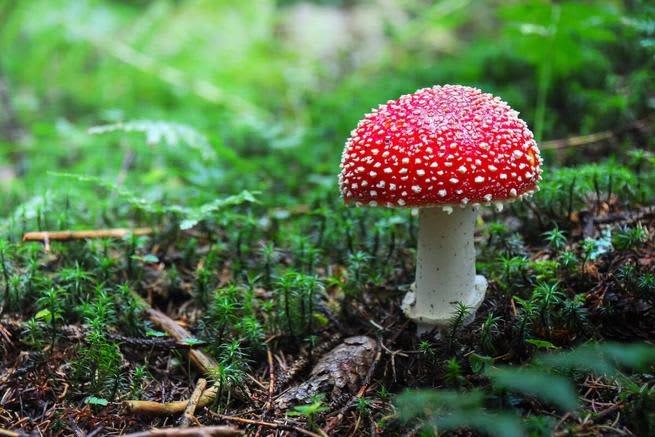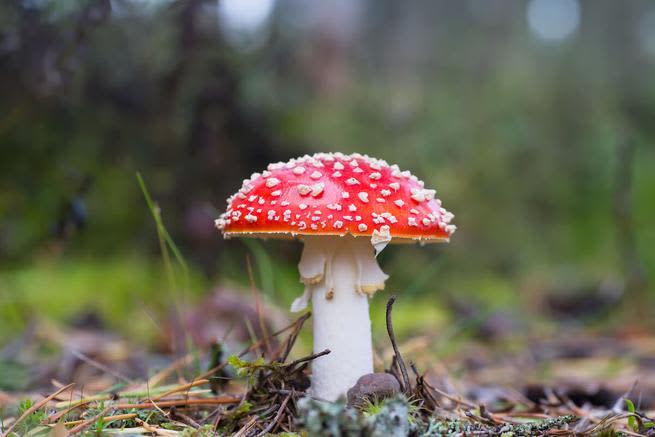

Have you ever wondered which mushroom species is the famous fungus emoji based on? Well, you’ve come to the right place—Amanita muscaria is, quite possibly, the most stereotypical mushroom species worldwide.
The vivid red color, thick stem, and numerous white scales are a staple of this fascinating shroom, which also has a rich history of use by ancient cultures. Yet, not many people know that A. muscaria is highly poisonous. Here’s what you need to know.
What is Amanita muscaria?
Amanita muscaria, popularly known as fly agaric or fly amanita, is one of the most iconic mushrooms worldwide. From Alice’s Adventures in Wonderland to Super Mario, A. muscaria is present all over Western culture.
But despite its friendly and eye-catching appearance, A. muscaria is a highly poisonous mushroom that can cause many side effects. These range from restlessness and gastrointestinal discomforts to agitation and drowsiness, among others. Researchers point out that these side effects come from three main compounds: muscarine, ibotenic acid, and muscimol.
In some rare cases, ingestion of fly agarics may even lead to death.
At the same time, A. muscaria is also a known psychedelic that can cause auditory and visual distortions and an altered state of mind. In fact, many of the fly agaric-related poisonings come from novice mushroom hunters looking for a quick psychedelic trip in nature (1).
However, it’s possible to remove the toxins from the mushroom and eat it only for its culinary value. But as you can probably imagine, this has never been a common practice—except for some countries in Northeastern Europe and Asia.
The curious common name “fly agaric” comes from the fact that the species is sometimes used as an insecticide. Allegedly, sprinkling dried A. muscaria caps with milk can attract and kill flies and other nearby insects.
How do fly agaric mushrooms look?

The usual A. muscaria has a convex 7–21 cm (2.7–8.2 in) cap that’s usually covered in small, cottony white spots (or white warts). The color is quite distinctive, ranging from a bright reddish orange to a dull orange, and the gills are short and white.
The white stem or stipe is 7–18 cm (2.7–7 in) long and somewhat thick, often showing a swollen base. A distinctive feature of A. muscaria is the white skirtlike ring at the top of the stem—a remnant of the universal veil (or volva) that previously covered the fungus. The spore print is entirely white (2).
What are the varieties of Amanita muscaria?

Currently, there are five main varieties of Amanita muscaria, which mostly differ in color:
- Amanita muscaria var. alba (white cap)
- Amanita muscaria var. flavivolvata (bright red cap but yellow warts and veil remnants)
- Amanita muscaria var. guessowii (orange to yellow cap)
- Amanita muscaria var. muscaria (the type fly amanita)
- Amanita muscaria var. persicina (peach-colored cap)
There are some other slight differences between the species, mainly concerning the size, the ring on the stem, and the number of warts on the cap. However, these variations are very subtle—so it’s best to try to identify these varieties for their color (2).
It’s also important to know that there are other varieties of A. muscaria, such as Amanita muscaria var. formosa or Amanita muscaria var. americana. These are somewhat disputed by some mycologists who claim they’re synonyms for the previous varieties (3).
Renowned mycologist Michael Kuo also states that the taxonomy of the species will probably change soon due to recent advancements involving DNA research. These studies claim that color differences don’t necessarily mean much genetic difference—but more research is needed to fully confirm this (4).
History of Amanita muscaria

Amanita muscaria is present throughout Western culture, commonly depicted in children’s books, video games, and movies. But this fascination over the fly agaric isn’t new—experts indicate that humans have been using A. muscaria for hundreds, if not thousands, of years.
The first people who used A. muscaria that we know of were the berserkers of the Viking kingdoms. The berserkers were fierce warriors known for their tolerance to extreme pain and lack of fear, who often went on seemingly superhuman fighting frenzies.
One of the leading theories regarding berserkers is that they consumed A. muscaria before going to war, taking advantage of its hallucinogenic and fear-inhibiting properties. This theory is supported by several records documenting Viking berserkers foaming at the mouth and having no control during their fighting frenzies (5).
However, not everything related to Amanita muscaria in folklore involves blood and battles. Researchers also believe that the red garments of Santa Claus come from traditional pre-Christian rituals practiced in Siberian Europe and Asia. These ceremonies often involved collecting and eating fly agaric mushrooms—which are red and known to cause a rosy flush to the cheeks.
These ceremonies often involved shamans dressed in red coats and pants who collected the fungi before returning to the village. The shamans wouldn’t return to their homes through the front door—instead, they would enter through the smoke hole on the roof of the main tents.
Once inside, the shamans would share and consume the fly amanita mushrooms with the participants. According to records, the participants often experienced hallucinations that felt like being on a sleigh pulled by reindeer or horses. Does any of this sound familiar? (6)
While these stories about A. muscaria are fascinating, the first official description of the species didn’t appear until 1753. At the time, renowned mycologist Carl Linnaeus formally described the species under the name Agaricus muscarius. This was later corrected by Christiaan Hendrik Persoon, who transferred it to the genus Amanita in 1783 (7).
Since then, not much has changed except for categorizing the different varieties. But research on fly agarics is always moving. Who knows what else experts can find out about the traditional use of these fascinating fungi?
Health benefits of Amanita muscaria

Unfortunately, fly amanita mushrooms have little to no nutritional or medical interest due to their poisonous nature. The little available research highlights only a few properties—but none are easily obtainable from wild fly agarics.
The first one is A. muscaria’s potential anticarcinogenic effects, which come from a compound called muscimol. Muscimol can inhibit the proliferation of cells in the nervous system, peripheral organs, and tumor tissues. As such, it could attenuate cancer growth in certain parts of the body—more specifically, it has shown promise in treating gastric cancer.
The other benefit is its antioxidant properties, which stem from the presence of compounds such as tocopherols and ascorbic acid. While researchers don’t give many details regarding how this works, they point out that Amanita muscaria may help treat neuroblastoma (1).
Naturally, the toxicity of A. muscaria makes these benefits almost unattainable for most people. You should never attempt to use fly agarics for these medicinal properties—doing so is more likely to cause harm rather than good.
Do fly agaric fungi share the same properties as magic mushrooms?
The hallucinogenic and psychedelic effects of A. muscaria may lead some people to believe they could share the same benefits as traditional magic mushrooms, such as Psilocybe cubensis. Unfortunately, there’s no evidence to support this.
While it’s true that some compounds in Amanita muscaria resemble those in psilocybe mushrooms, the two kinds of fungi are wildly different.
Most importantly, psilocybin-containing fungi are considered a relatively safe drug for most people. A. muscaria, instead, is a toxic mushroom—which renders all of its potential therapeutic applications unusable.
Similarly, the actual psychoactive effects are different. Psilocybe fungi are known to cause grounded and peaceful hallucinations in moderate doses, giving people a sense of calmness and spirituality. On the other hand, fly agarics’ effects are considered to be delirant—meaning that the visuals are much more frenetic and are almost indistinguishable from reality.
As such, it’s hard to tell whether or not this shroom could be used as a therapeutic tool in the future. Regardless, its toxicology means you should never attempt to try it on your own.
Where does Amanita muscaria grow?

Amanita muscaria is native to Europe and Asia, with a particular preference for Siberia. It’s absent from the rest of the continents, except for some rare sightings in North America (mostly in western Alaska and Canada) and some artificially introduced populations in Australia, New Zealand, and South America.
Fly amanitas are mycorrhizal mushrooms—meaning they live in a symbiotic (mutually beneficial) relationship with the host tree. Usually, they grow near the roots of conifers and hardwoods. They seem to be particularly fond of trees such as pines, spruces, and birches (2).
The fruiting bodies appear from late summer through early winter, often near patches of the delicious porcini mushrooms (Boletus edulis). Renowned mycologist Tom Volk recommends considering this when looking for either species (8).
What is ethical wildcrafting?
Ethical wildcrafting refers to harvesting wild mushrooms without damaging the surrounding ecosystem. Wildcrafting is often confused with foraging—the critical difference is that the former refers to harvesting for medicinal purposes and the latter for eating.
Most novice mushroom hunters are unaware of the environmental damage they can cause by harvesting carelessly. However, practicing ethical wildcrafting is as simple as following these simple rules:
- Do your research before heading out—note any possible toxic or endangered lookalikes you may encounter on the field.
- Get your hands on a field guide—these useful manuals will teach you about the ecosystem and where to find your desired species.
- Pick the fruiting bodies gently—use your hands whenever possible, saving knives and scissors for when absolutely necessary.
- Avoid overharvesting—take only what you need, and don’t share patch locations with others.
- Get on the legal side of things—ask permission from the landowner (if wildcrafting on private land) or check local harvesting regulations (if on public land).
If you’re new to the mushroom world, we recommend looking for harvesting groups in your area. Experienced fungi hunters will usually be happy to teach you the basics of ethical wildcrafting while keeping you away from dangerous species.
Is it safe to wildcraft for fly agaric mushrooms?
No, it’s never safe to eat wild fly agaric mushrooms. While it’s true that not all A. muscaria specimens are toxic, it’s impossible to tell unless you’re an expert mycologist with heavily specialized equipment.
If you’re set on eating A. muscaria, make sure to check with a professional first. Some cultures have incorporated fly agaric fungi into their kitchens—but they go through stringent cooking methods to thoroughly remove their toxins.
How do you take Amanita muscaria?

There isn’t a defined way to take A. muscaria. Due to its toxic effects, almost no one takes the species recreationally or for its culinary values.
However, some mycologists argue that parboiling the species can remove most toxins, making them safe to eat. We don’t encourage you to try this, but it’s important to know that professional cooks may use A. muscaria as an ingredient in sophisticated dishes (9).
Consumption of this shroom seems to be rare in most cultures—and for a fair reason. Even if you could remove all the toxic compounds, neither the flavor nor the hallucinogenic properties offered by the species seem to be particularly enjoyable.
Amanita muscaria: From Santa Claus to Super Mario
Amanita muscaria mushrooms have left their mark all over Western culture, from children’s books to fairytales told through oral tradition. Unfortunately, eating the species will lead to dangerous side effects—so it’s best to just enjoy them for their stunning beauty and historical value.
If you want to discover other hallucinogenic mushrooms, keep up on shroomer. We cover every kind of edible mushroom, from choice edibles to shrooms, so you’ll surely find a fine replacement for Amanita muscaria.
References
- Quentin Carboué, Michel Lopez. “Amanita muscaria: Ecology, Chemistry, Myths.” Encyclopedia 1(3) (2021): 905-914. https://doi.org/10.3390/encyclopedia1030069
- Michael Kuo. “Amanita muscaria var. muscaria.” MushroomExpert.com (2019). https://www.mushroomexpert.com/amanita_muscaria_muscaria.html
- Mycobank. “Amanita muscaria.” (Last accessed September 27, 2023). https://www.mycobank.org/page/Name%20details%20page/1133
- Michael Kuo. “Amanita muscaria var. alba.” MushroomExpert.com (2013). https://www.mushroomexpert.com/amanita_muscaria_alba.html
- Adrian Morgan. “Berserkers” in Toads and Toadstools: The Natural History, Folklore, and Cultural Oddities of a Strange Association (1995): 115–118.
- U.S. Forest Service. “Fly Agaric.” (Last accessed September 27, 2023). https://www.fs.usda.gov/wildflowers/ethnobotany/Mind_and_Spirit/flyagaric.shtml
- First Nature. “Amanita muscaria (L.) Pers. - Fly Agaric.” (Last accessed September 27, 2023). https://www.first-nature.com/fungi/amanita-muscaria.php
- Tom Vulk. “Tom Volk’s Fungus of the Month for December 1999.” Tom Volk’s Fungus (1999). https://botit.botany.wisc.edu/toms_fungi/dec99.html
- Debbie Viess. “Further Reflections on Amanita muscaria as an Edible Species.” Bay Area Mycological Society (2011). http://bayareamushrooms.org/education/further_reflections_amanita_muscaria.html


